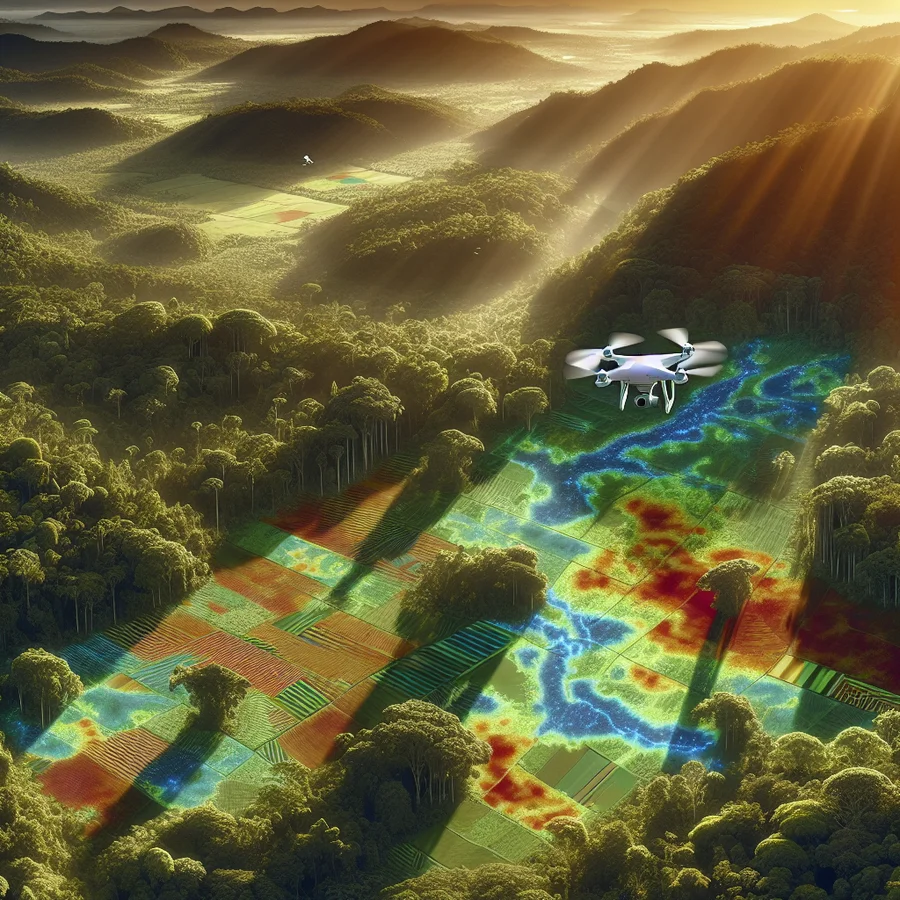AI in Environmental Monitoring: Analyzing Data and Predicting Trends
Our planet faces significant environmental challenges. These include climate change, pollution, and biodiversity loss. Addressing these issues requires innovative solutions. Artificial intelligence (AI) offers powerful tools for environmental monitoring. It helps us analyze data and predict trends with greater accuracy and speed.
This guide explores how AI in environmental monitoring is revolutionizing the field. We’ll examine its applications in pollution control, climate change research, and biodiversity conservation. You’ll discover how AI algorithms are helping us understand and protect our environment.
The Role of AI in Environmental Monitoring
Environmental monitoring is crucial for understanding the health of our planet. It involves collecting and analyzing data about various environmental factors. These factors include air and water quality, temperature, and species distribution. Traditional methods are often costly and slow. AI offers a more efficient and effective approach.
AI can automate data collection and processing. It uses sensors, drones, and satellites to gather real-time data. This data provides accurate insights into environmental parameters. AI also improves prediction accuracy for events like wildfires and floods. It aids in detecting endangered species and analyzing habitat changes.
Note: AI provides transparent and accessible information. This promotes collaboration between scientists, policymakers, and the public.
Benefits of Using AI in Environmental Monitoring
AI offers several key advantages over traditional monitoring methods:
- Increased Efficiency: AI algorithms can process large datasets quickly. This saves time and resources.
- Improved Accuracy: AI can identify subtle patterns and trends that humans might miss.
- Real-Time Insights: AI-powered sensors provide continuous data streams. This allows for timely interventions.
- Predictive Capabilities: AI models can forecast future environmental conditions. This helps with proactive planning.
- Cost-Effectiveness: Automating tasks reduces the need for manual labor.
These benefits make AI an invaluable tool for environmental protection.
AI in Detecting and Combating Pollution
Pollution poses a significant threat to human health and ecosystems. Early detection and intervention are crucial. AI in environmental monitoring plays a vital role in identifying pollution sources and mitigating their impact.
AI can analyze data from various sources to detect pollution. These sources include industrial emissions, car exhausts, and agricultural runoff. Understanding these sources allows for targeted measures. These measures include cleaner technologies and emission regulations.
Reminder: Effective pollution detection helps enforce environmental laws. This ensures compliance and promotes sustainable practices.
Data Collection and Analysis for Pollution Detection
AI uses sensors and IoT devices to collect real-time data on air, water, and soil quality. Programming languages like Python are ideal for managing this data flow. Libraries like Pandas process and organize the data. R performs in-depth statistical analysis and visualization.
For example, IoT-based monitoring of air and water quality provides data on pollutants. These pollutants include particulate matter and ozone. AI and IoT also optimize soil quality in agriculture. This improves irrigation and fertilization for better crop yields.
Identifying Pollution Sources with AI
AI algorithms can analyze pollution data to identify its sources. Machine learning models classify air quality categories. They also calculate the pollution contribution of different sources. This helps authorities target interventions effectively.
For instance, a smart platform can monitor and identify environmental pollutants. It uses web-scraping techniques to gather data. AI improves public accessibility and understanding of pollution data.
Monitoring and Compliance with Regulations Using AI
<
AI enables real-time pollution monitoring systems. These systems alert authorities for immediate action. Python frameworks support real-time data visualization and interactive web applications.
For example, IoT and deep learning algorithms can monitor and forecast air pollution. These systems can predict particulate matter levels. Wireless systems monitor air and noise pollution with data visualization.
Raising Public Awareness and Community Engagement
Public awareness is crucial for community action towards a cleaner environment. AI technologies enhance these campaigns. They analyze social media data to gauge sentiment and optimize outreach.
For instance, AI can identify pollution sources using data mining techniques. This provides actionable insights for public awareness programs. AI also helps develop targeted public engagement strategies for ocean pollution.
AI in Climate Change Research and Mitigation
Climate change poses a significant threat to our planet. It causes global warming, rising sea levels, and extreme weather events. AI in environmental monitoring is crucial for understanding and mitigating these effects.
AI can analyze vast amounts of climate data. This data includes temperature readings, ice cover, and greenhouse gas emissions. This analysis helps scientists understand climate patterns and predict future changes. It also aids in developing strategies to reduce greenhouse gas emissions.
Note: Effective climate monitoring helps policymakers create action plans. These plans balance economic development and environmental protection.
Data Analysis, Modeling, and Predictions for Climate Change
Statistical analysis is key to understanding climate trends. Both Python and R excel in this area. AI and machine learning enhance climate modeling and prediction. Python libraries develop predictive models analyzing historical data.
For example, a dynamic machine learning model predicts air quality. It uses fuzzy logic to handle uncertainty and improve accuracy. Multiple linear regression predicts pollutant concentrations. LSTM and CNN models outperform traditional models in air pollution prediction.
Impact Assessment and Decision Support
Understanding the impacts of climate change is crucial. It helps develop effective adaptation and mitigation strategies. Machine learning models simulate different climate scenarios. They help policymakers make informed decisions.
For instance, machine learning models predict extreme weather events. They also improve the effectiveness of early warning systems. Integrating climate and socioeconomic data identifies vulnerable communities.
AI-Enabled Strategies for Climate Change Adaptation
AI can identify vulnerable areas and develop plans for protecting infrastructure. AI-powered sensors monitor the impacts of extreme weather events. Machine learning algorithms develop predictive models for climate change impacts.
For example, AI can analyze satellite imagery to identify areas at risk of flooding. It can also analyze climate models to identify areas likely to experience changes in temperature. This helps governments develop targeted adaptation plans.
AI in Biodiversity Conservation
Biodiversity loss is a major environmental challenge. It threatens ecosystems and the services they provide. AI in environmental monitoring plays a crucial role in biodiversity conservation.
AI can identify different species from images and videos. This makes it easier for researchers to study biodiversity. AI can also map habitats and track changes over time. This provides crucial data for conservation planning.
Reminder: Predictive analytics, powered by AI, can forecast the likelihood of species becoming endangered. This allows for proactive measures to protect vulnerable species.
Use of AI for Species Identification and Habitat Mapping
AI algorithms can analyze images and videos to identify species. This automates the process of species identification. AI can also map habitats using satellite imagery and sensor data. This helps conservationists understand species distribution.
For instance, AI can analyze camera trap images to identify wildlife. It can also map forest cover using satellite data. This information is crucial for monitoring biodiversity.
Predictive Analytics for Endangered Species Protection
AI can analyze various factors to predict the likelihood of species becoming endangered. These factors include habitat conditions, climate change, and human activities. This allows conservationists to take proactive measures.
For example, AI can predict the impact of deforestation on species populations. It can also predict the impact of climate change on habitat suitability. This helps conservationists prioritize their efforts.
Success Stories of AI in Biodiversity Projects
AI has been used successfully in various biodiversity projects. For instance, AI has helped monitor coral health in the Great Barrier Reef. It has also helped track and protect elephants in Africa.
For example, AI has been used to monitor coral bleaching events. It has also been used to reduce instances of poaching. These success stories demonstrate the potential of AI in biodiversity conservation.
Challenges and Ethical Considerations
While AI offers numerous benefits, it also presents challenges. These challenges include data privacy, model bias, and interpretability. Addressing these challenges is crucial for fully leveraging AI’s potential.
<
Data quality is also a concern. AI models require high-quality data to function effectively. In resource-constrained regions, data may be limited or unreliable. This can affect the accuracy of AI-driven insights.
Addressing Data Privacy Concerns
Data privacy is a significant concern when using AI. Environmental monitoring often involves collecting sensitive data. This data includes information about species locations and human activities.
To address these concerns, it’s essential to implement robust data protection measures. These measures include anonymization, encryption, and access controls. Transparency about data usage is also crucial.
Mitigating Model Bias in AI Applications
AI models can be biased if trained on biased data. This can lead to inaccurate or unfair outcomes. For example, a model trained on data from one region may not perform well in another.
To mitigate bias, it’s essential to use diverse and representative datasets. Regular audits of AI models can also help identify and correct biases. Explainable AI (XAI) models can improve transparency and trust.
Ensuring Interpretability of AI Models
Many AI models are “black boxes.” This means it’s difficult to understand how they arrive at their conclusions. This lack of interpretability can be a problem in environmental monitoring.
To address this, researchers are developing XAI models. These models provide insights into the decision-making process. This helps build trust and ensures accountability.
The Future of AI in Environmental Monitoring
The future of AI in environmental monitoring looks promising. Continued advancements in AI technology will lead to even more innovative applications. These applications will further enhance our ability to protect the environment.
Collaborative efforts between governments, businesses, and research institutions are crucial. These efforts will help unlock the full potential of AI for environmental sustainability. By working together, we can create a better future for all.
Emerging Trends and Technologies
Several emerging trends are shaping the future of AI in environmental monitoring. These include:
- Edge Computing: Processing data closer to the source reduces latency and improves efficiency.
- Federated Learning: Training AI models on decentralized data sources protects privacy.
- AI-Powered Drones: Drones equipped with AI can autonomously monitor remote areas.
- Digital Twins: Creating virtual replicas of ecosystems allows for simulations and predictions.
These technologies will enable more efficient and effective environmental monitoring.
The Role of Data Quality and Availability
Data quality and availability are crucial for the success of AI in environmental monitoring. High-quality data ensures accurate and reliable results. Open data initiatives promote data sharing and collaboration.
Investing in data infrastructure is essential. This includes sensors, satellites, and data management systems. Standardized data formats and protocols facilitate data integration.
Collaborative Efforts for Sustainable Development
Collaborative efforts are essential for sustainable development. Governments, businesses, and research institutions must work together. This will help unlock the full potential of AI for environmental sustainability.
Public-private partnerships can drive innovation. International collaborations promote knowledge sharing. Community engagement ensures that AI solutions are equitable and inclusive.
Conclusion
AI in environmental monitoring is transforming how we understand and protect our planet. From detecting pollution to predicting climate change impacts, AI offers powerful tools for data analysis and trend prediction. While challenges remain, the potential benefits are immense. By embracing AI and addressing ethical considerations, we can create a more sustainable and resilient future.
The integration of AI, programming languages, and data analytics has revolutionized environmental monitoring. These technologies enhance data analysis, automate reporting, and improve communication. They enable more informed and timely decision-making. As AI continues to evolve, its applications in environmental sciences will significantly contribute to sustainable development and conservation efforts globally.
FAQs
How does AI help in monitoring air quality?
AI uses sensors and machine learning algorithms to analyze air quality data in real-time. It can identify pollutants, predict air quality levels, and alert authorities when pollution levels are high. This helps in taking timely actions to protect public health.
What role does AI play in climate change research?
AI analyzes vast amounts of climate data to create accurate models and predictions. These models help scientists understand climate patterns and forecast future changes. AI also aids in developing strategies to reduce greenhouse gas emissions and mitigate climate change impacts.
How can AI assist in biodiversity conservation?
AI can identify different species from images and videos, making it easier for researchers to study biodiversity. It can also map habitats and track changes over time, providing crucial data for conservation planning. Predictive analytics, powered by AI, can forecast the likelihood of species becoming endangered.
What are the ethical considerations when using AI in environmental monitoring?
Ethical considerations include data privacy, model bias, and interpretability. It’s essential to implement robust data protection measures, use diverse and representative datasets, and develop explainable AI (XAI) models to ensure transparency and trust.
What are some emerging trends in AI for environmental monitoring?
Emerging trends include edge computing, federated learning, AI-powered drones, and digital twins. These technologies will enable more efficient and effective environmental monitoring by processing data closer to the source, protecting privacy, autonomously monitoring remote areas, and creating virtual replicas of ecosystems for simulations and predictions.






